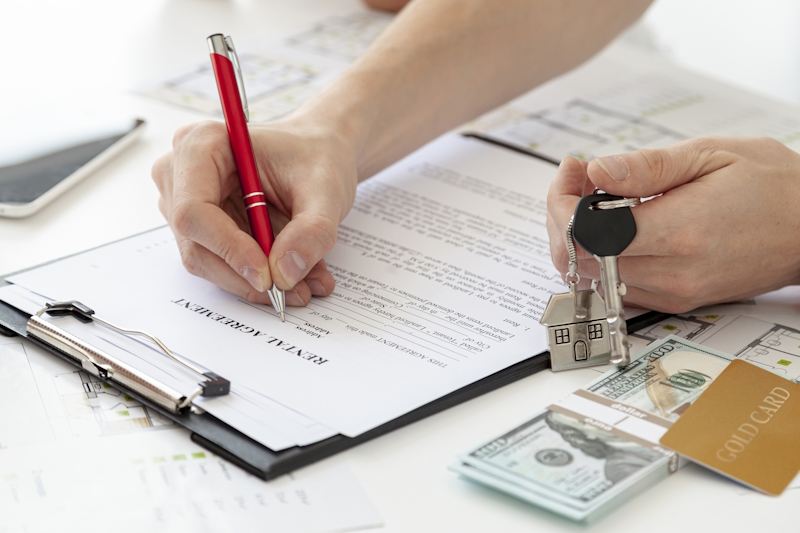A lease is a written agreement between a property owner and a tenant that explains the terms and conditions for renting out the property. If you decide to write your own lease, learn steps for creating a legally compliant lease to ensure it includes a clause stating that if any part of the lease is not legal, the rest of the agreement still remains valid.
“You always hear the phrase, money doesn’t buy you happiness. But I always figured a lot of money would buy at least a little bit of happiness. But it’s not really true. I got a new car because the old one’s lease expired,” said Sergey Brin, co-founder of Google.
As a new homeowner looking to rent out your property, it’s important to create a lease with terms that attract tenants. A lease agreement is a legal document that outlines the roles and responsibilities of both the landlord and the tenant.
What Is a Lease Agreement?
A lease agreement is a contract that lays out the terms under which one person agrees to rent property owned by someone else. It includes the duties and rights of both the landlord (property owner) and the tenant.
By law, the tenant (also called the lessee) has the right to use the property, and the landlord (also known as the lessor) receives regular payments for an agreed time. This contract is legally binding and protects both the landlord’s and the tenant’s rights.
Key Parts of a Lease Agreement
- Names of All Tenants or Occupants
Every adult living in the rental property should be named in the agreement and sign it. This helps the landlord ensure that everyone is responsible for the rental terms. - Description of the Property
The lease should include the full address of the property, including the unit number if there is one. If the rental includes a parking space, that should also be mentioned. Areas of the property that the tenant is not allowed to use should be clearly stated to prevent any misunderstanding. - Length of the Tenancy
Be clear about when the lease starts, how long it lasts, and when it ends. A lease sets a specific time frame, unlike rental agreements that renew each month. - Security Deposit Details
To avoid disputes, clearly state how much the security deposit is, the rules about returning it, and any fees. Follow your state’s rules for things like the maximum deposit and the notice needed to end a monthly lease. - Rent Information
The agreement should state the rent amount, the due date, and how rent should be paid. If there is a late fee, include how much it is and if there is a grace period. - Repairs and Maintenance
The lease should explain that the tenant must take reasonable care of the property. It should also say who is responsible for what repairs and how maintenance will be handled. - Landlord’s Right to Enter the Property
Make sure your lease explains when and how you can enter the rental unit. For example, you might say that you will give 24-hour notice before entering for repairs. This protects your rights and respects the tenant’s privacy. - Tenant Responsibilities
If you have any specific rules that are important, like no smoking or no pets, and would be grounds for ending the lease if broken, clearly include them in the agreement. - Contact Details
The lease should list how to reach both the landlord and the tenants. You may also want to require that tenants contact you in writing for certain issues. - Other Rules or Restrictions
You may need to add certain details to follow federal, state, or local laws. The agreement should not go against rent control laws, anti-discrimination rules, or health and safety codes.
7 Online Lease Agreement Templates You Can Use
- Lease Agreement Form
This template lets you create a legally binding lease that lasts until the rental term ends. It is good for landlords, business owners, and property investors. - Equipment Lease Agreement Form
This form can be used to rent out equipment and includes terms for rental fees, loss, or damage. - Car Rental Agreement Form
With this form, you can create a basic car rental agreement between your car rental business and customers. - Land Lease Agreement Form
This template works well for renting land for farming or commercial use. It creates a clear contract between the landowner and the renter. - Office Lease Agreement Form
This form is used to create a contract for renting an office space. It can be adjusted to include services like cleaning or utilities. - Sublease Agreement Form
If you’re subleasing a property you’re already renting, this template helps create a contract between you and your new sub-tenant. - Lease Renewal Agreement Form
This form is used to extend an existing lease. It allows both parties to make updates before signing a new term.
Types of Lease Agreements
Operating Lease Agreement
This type of lease is more like a rental. The owner allows someone to use the property for a set time, but ownership does not transfer.
Capital or Financial Lease Agreement
In this lease, the finance company owns the asset during the lease, and all ownership risks and benefits are passed on to the tenant.
Sale and Leaseback Agreement
This is when someone sells a property and then rents it back. The seller continues using the property but no longer owns it.
Combination Lease Agreement
This lease mixes features of operating and financial leases. For example, a lease might include a cancellation clause and long-term use.
Synthetic Lease Agreement
This is used when a company sets up a separate business to buy equipment. The company uses the asset without listing it on their books.
Other Useful Agreement Forms
- Photography Consent Form: Grants permission for use of images in photography.
- Guarantor Agreement Form: Used when someone is backing another person’s lease.
- Non-Disclosure Agreement (NDA): Protects company secrets from being shared.
- Music Release Form: Grants permission for music use.
- Model Release Form: Used by photographers or studios to get permission to use a model’s image.
- Roommate Agreement Form: Helps manage shared living arrangements.
How to Make an Online Lease Agreement with Formplus
- Sign Up
Register using your Google, Facebook, or email account. - Enter Lease Title and Add Form Fields
Start creating your lease by entering a title and adding fields like checkboxes, radio buttons, or images. - Customize the Form
Change the layout, add your logo, edit button text, and choose fonts or colors. If you have CSS, you can add it to the form. - Set Form Options
Pick your storage option (Google Drive, Dropbox, etc.), limit responses, use Captcha, and collect location data. You can also set up automatic email replies. - Share the Form
Copy the form link, create a pop-up or embed code, or download a QR code for easy sharing. - View Responses
Check responses in different formats like cards or tables. You can turn data into graphs and key insights. - Use Formplus Analytics
Track the number of responses, form views, abandonment rate, average time spent, device used, and more. View charts showing your form’s performance.
Terms to Check Before Signing a Lease
- Right to Renew: If the tenant can renew the lease, this should be clearly written.
- Parking Rules: Any parking terms should be included.
- Restricted Items: If any items are not allowed on the property, this should be stated.
- Property Rules: In shared properties, the landlord may list rules like no repairs in the yard.
- Right to Sublease: If the tenant can sublet the space, this must be included in the agreement.
FAQ
Is leasing cheaper than renting?
Not always. A lease may come with added costs like property taxes, repairs, and insurance. Renters usually contact the landlord for maintenance.
What’s the difference between a lease and a rental agreement?
Both are contracts, but rental agreements are usually short-term and renewed monthly. Leases are for a fixed period, often 12 months or more.
Is leasing better than renting?
It depends on your needs. Leasing is good for long-term stability. Renting is better if you need flexibility or plan to move soon.
Conclusion
The purpose of a lease is to make things clear and fair for both the landlord and tenant. Creating a lease—whether for a shop, home, or office—should not be hard. A good lease helps both sides know what they’re agreeing to.
Having open communication early on helps avoid problems later. Making the leasing process easier for landlords and small business renters also helps boost productivity. Both parties should take the time to carefully review and understand the lease before signing.










